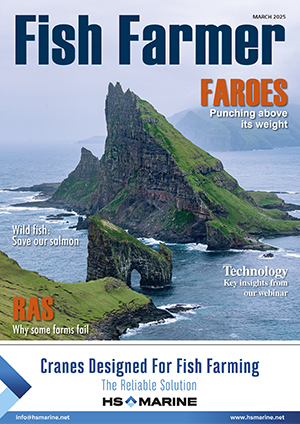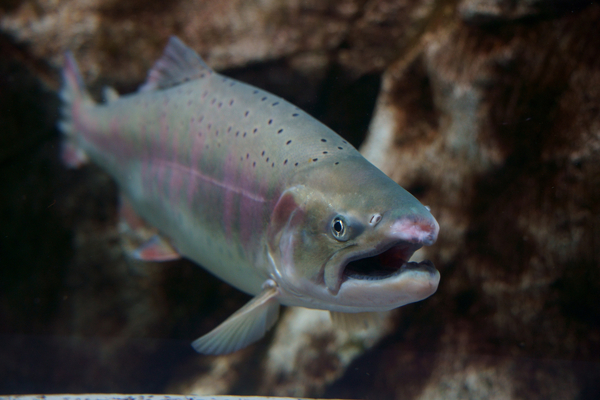Hearts and minds at TriNations 2024

The TriNations initiative brings together industry and academic experts to share the latest updates on farmed fish health. Chris Mitchell reports on latest TriNations event, held earlier this year in Bergen.
For a diminishing number of TriNations veterans, the opportunity to revisit Bergen for this meeting was tinged with mixed memories as the intervention of the Eyjafjallajökull volcano in the 2000 meeting made the journey home a lot more interesting than the journey out! There were no such challenges, though, for the approximately 120 delegates in March of this year who gathered for the 19th TriNations meeting.
The summaries from each territory started with Norway where, in terms of significance to industry, pancreas disease (PD) has recently been knocked into second place by cardiomyopathy syndrome (CMS), not because of any change in the status of the latter but through a significant diminution of the former, particularly in mid-Norway. The reduction from 158 cases in 2020 to just 58 in 2023 has been largely attributed to good cooperation between industry and the Food Safety Authority.
[caption id="attachment_163916" align="alignnone" width="387"] Production of large-smolt (graphic: Debes Christiansen, Faroes Food and Veterinary Authority and Runi Dam, AVRIK)[/caption]
In contrast, Ireland has seen an elevation in mortalities attributed to PD, whilst recognising that often the distinction between “died with” and “died from” can be a tricky call.
Meanwhile in the Faroes, salmon alpha virus (SAV) remains absent whilst CMS continues to be associated with mortality, particularly following thermal treatments for sea lice. For this reason, the rather high numbers of mortalities associated with “handling” are likely inflated by the presence of this virus. That said, the lowest number reported in the last six years was, encouragingly, in 2023. This might in some ways be related to the decision across those islands to gradually increase the transfer weight of smolt going to sea, reducing the time they spend there and, by extension, the number of handling Events & Webinars News which they undergo.
Whilst piscine orthoreovirus (PRV) remains ubiquitous across the territories, there is some concern in the Faroes that it is becoming clinically more problematic, with a view expressed that this might be due to a change in virulence of PRV 1, the culprit strain.
[caption id="attachment_163923" align="alignnone" width="214"] Ralph Bickerdike, Scottish Sea Farms[/caption]
Key challenges
A drill-down into “experiences in industry” revealed two themes that keep health practitioners up at night; the impact of environmental challenges on fish infected with SAV and the impact of CMS on its own. In respect of the latter, Ralph Bickerdike of Scottish Sea Farms drew attention to the global climate cycle, of which El Niño is a part, as influencing mortality levels on farms. This part of the cycle saw sea temperatures in the winter following the warm summer of 2022 never really return to their seasonal norms and it was against this background that CMS contributed significantly to the 10% of mortality attributed to viremias, often at the valuable end of the production cycle.
[caption id="attachment_163922" align="alignnone" width="200"] Kim McKinnell, Bakkafrost Scotland[/caption]
Meanwhile, Kim McKinnell from Bakkafrost Scotland detailed how infection with SAV can seriously exacerbate the negative outcomes which often accrue from seasonal influxes of jellyfish. A relatively low burden of jellyfish impacting salmon infected with SAV at one site resulted in a significantly greater mortality than at another site with a lot more jellyfish, but no PD. Kim uses biomarkers as real-time trackers for the impact of both environmental insults and viral ones with so-called “lead” (warning of) and “lag” (responding to) indicators for prognosis mapping.
[caption id="attachment_163919" align="alignnone" width="300"] The Steering Committee and Reference Group[/caption]
Whilst not a new technology per se, the use of biomarkers in fish health generally, and PD in particular, is gaining traction in the biologist’s toolbox. PatoGen is developing a prognostic tool based on up to seven different biomarkers for tracking myopathies in affected fish. By comparing biomarker levels with heart pathology in fish infected with SAV 2, they hope that blood testing can be a diagnostic tool that does not require individual fish to be sacrificed for the benefit of their peers.
WellFish Tech too are keen to promote the use of clinical chemistry, not so much in a diagnostic context but rather as a monitor of general health over the production cycle. By comparing biomarker levels within the context of each other, and using AI to mine the data, patterns have emerged which indicate defined “health panels” of which at least one is used to track SAV from infection to clinical disease and recovery.
[caption id="attachment_163921" align="alignnone" width="360"] Efforts to combat PD in Production Area 7[/caption]
Combating the impact, and preventing the spread, of the viruses of TriNations interest revealed new progress from both perspectives. Skretting has a new functional feed based on enrichment with EHA and DPA (the two main types of long-chain omega-3 fatty acids). With these additives, fish with CMS appeared to exhibit some level of mitigation, reinforcing the association between dietary factors, viral load and overall fish health.
Norway’s success over the past years in bringing down levels of PD, is well illustrated in Production Area 7 where, by splitting the area into smaller zones of cooperation, joint fallowing has naturally followed, and no PD has been identified since 2020 even when infection was introduced into the neighbouring area, Production Area 8 in 2023, most probably through three well boat operations. The situation was quickly contained before it could spread to Area 7.
The impact of synchronized fallowing has been demonstrated using variants PRV1 as the tag virus. Genetic mapping of these demonstrated that fallowing prevented transmission between sites and that any horizontal dissemination of the virus (after an introduction) was anthropogenic rather than current mediated. The obvious mitigation suggested is, therefore, improved biosecurity.
For sites that are hydrodynamically connected, the degree of water contact between them is largely determined by wind, according to the marine intelligence and forecasting company Oceanbox, which has developed a new tool to measure this. However, because wind patterns rarely follow an annual cycle, the predictive capability will require further refinement.
[caption id="attachment_163920" align="alignnone" width="300"] Bergen[/caption]
Molecular biology
Advances in molecular biology within the lifetime of the TriNations have been transformative with the continuous development of new epidemiological, diagnostic and prognostic applications.
An improved understanding of the piscine myocarditis virus (PMCV) genome is not only important for advancing the development of molecular vaccines to this virus but is also an enabler for detailed epidemiological tracking in the farming areas where it occurs. By mapping PMCV lineages, its occurrence in different geographies can be both explained and mapped, important for exploring likely vectors as well as developing effective biosecurity mitigation.
In the Faroe Islands, this genomic approach has led to the discovery that these islands are not subject to continuous reintroduction of PMCV. Instead, there exists a monophyletic cluster originating from farmed salmon which is distinct from PMCV found locally in wild salmon. Perhaps disappointingly, no correlation emerged in this study between recorded cases of CMS and potential virulence markers.
Virulence in any viral infection requires the pathogen to successfully replicate in the host, which is normally pathogenic. The mechanism by which PMCV does this remains something of a mystery. The virus is a member of the Totiviridae, a large group of viruses which mostly affect unicellular organisms and are propagated by those organisms undergoing cell division. The virus cannot itself achieve cellular entry by virtue of lacking a capsid component necessary to achieve this. That said, some totiviruses can infect certain arthropods (shrimps and mosquitoes) because they possess special fibre protrusions that facilitate entry. This is not a feature of PMCV, which is more closely related to the protozoan infecting totiviruses than the arthropod infecting ones. Salmon, clearly, are not protozoans!
[caption id="attachment_163924" align="alignnone" width="300"] Farm worker holding salmon[/caption]
Over the last decade totiviruses have increasingly, been described in a number of multicellular organisms. All of these viruses carry additional coding capacity for peptides that are functionally necessary for infection of these more advanced hosts. This may well explain how the PMCV totivirus can infect salmon, with others now described in lumpfish, golden shiner, common carp and sea bass. One protein, apparently “not found anywhere else in biology” has been identified in PMCV and, excitingly, small variations in this might serve to explain why the outcome of infection by it can be so variable.
As reported at the TriNations in Edinburgh, it has become quite clear that PMCV displays significant transcription activity within the spongiosum of the heart, a candidate cause in the resulting cardiac failure. In experimental infections, it has been shown that levels of virus replication are both dose, and tissue, dependent. The ventricle of the heart appears to be particularly sensitive in its response to viral replication whilst the head kidney might actually be the preferred site.
One important impact of virulence (that is CMS induced by PMCV infection) was, not surprisingly, found to affect cardiac function. Prior to assessing this effect, some baseline cardiology parameters were established in fish living a “simulated farmed life” (SIMFARM) and fish living a “simulated wild life” (SIMNAT). Fish in the former group underwent cardiac hypertrophic remodelling at smoltification meaning that the heart tissue needed to adapt to a greater workload when compared to the SIMNAT group. It was suggested that intense rearing protocols, particularly at raised temperatures, seemed to accelerate age-related cardiac impairment.
[caption id="attachment_163918" align="alignnone" width="300"] Faroes fish farm[/caption]
Whilst this is, of course, itself concerning, the authors of this work went on to measure and describe the impact of PMCV infection on these compromised hearts. The hearts of infected fish, it seems, work harder to maintain stroke volume and cardiac output than the hearts of non-infected fish. Compromised hearts will struggle to adapt and, during stressful Events & Webinars News, the increase in blood pressure within a weakened heart can lethally rupture the atrium. Given that the weakness can be a function of production practices in the freshwater phase, hearts which have developed properly in the early part of the cycle could be at a significant advantage in the latter, effectively equipping fish to deal with a potentially serious challenge later in their life.
Whilst never a headliner at TriNations meetings, PRV is of course always mentioned and usually with some new insights. Since 2017 it has been associated with severe disease outbreaks in Danish freshwater (trout) RAS aquaculture. Its precise impact though has been rather illusive given that qPCR examination of water and fish tissues often reveal different pathogen profiles in each with PRV 3 in fish, and pathogenic bacteria in water. The take home message here being, the two don’t correlate so perhaps best to monitor both!
PRV 3 is, as mentioned above, predominantly associated with complex disease cases in rainbow trout. A cohabitation challenge study, however, has recently shown that brown trout (Salmo trutta) can not only acquire PRV 3, but also facilitate replication of the virus, and exhibit cardiac lesions similar to those seen in Atlantic salmon diagnosed with heart and skeletal muscle inflammation (HSMI) resulting from infection with PRV 1. Given that a brown trout’s lineage is closer to an Atlantic salmon than to a rainbow trout, this outcome is perhaps surprising and possibly significant for the management of live fish movements.
The variations in susceptibility between salmonid species when infected with either of the PRV strains may also assist in the development of vaccines and other protective measures. For example, whilst PRV 3 infection does not cause disease in Atlantic salmon, it does appear capable of blocking infection with the pathogenic strain, PRV 1. Additionally, there is evidence that it elicits some cross-protection in the host fish.
[caption id="attachment_163925" align="alignnone" width="300"] Salmon with gills exposed[/caption]
DNA vaccines
Protection is arguably the most powerful tool in the disease-mitigation box, and this is normally achieved through vaccination. Elanco presented some compelling evidence supporting the accelerating success of its DNA vaccine specifically within the context of challenge with SAV 2 which remains problematic in Mid Norway.
Meanwhile, an innovative approach to the development and production of DNA vaccines going forward would see traditional plasmid production through fermentation being replaced by an enzymatic platform. Touchlight Aquaculture has a proprietary technology, “Doggybone DNA” (dbDNA™) which the company intends to introduce to produce vaccines against the three most important cardiomyopathies in salmon farming: PD, HSMI and CMS.
Touchlight claims that vaccine “take”, as measured by the production of neutralising antibodies, is greater in fish vaccinated with “doggybone”-derived constructs when compared to those from the traditional platform… a space worth watching!
The PD TriNations meeting continues, I believe effectively, to bring the world of cutting-edge research into salmonid viral myopathies to the pen side. It is vital that this unique forum remains the place where lab meets farm in a way that makes the work of the former accessible to later, and the issues facing the latter, on the radar of the former!
About the TriNations initiative
The TriNations initiative was established in 2005 with the aim to integrate and focus the activities of academia and industry from Norway, Ireland, Scotland and more recently other salmon farming regions with regard to fish health.
This industry-led initiative has made major contributions to developing a fuller understanding of PD and related conditions by encouraging new and collaborative research and sharing of results in a transparent manner. Greater knowledge of the risks associated with the development and spread of the disease as well as an understanding of the viral characteristics have helped shape strategies for disease prevention and mitigation for the benefit of the salmon farming industry.





Aquaculture Technical Co-ordinator - Scottish Sea Farms Ltd
Orkney, Shetland£30,000 to £35,000 per annum
Processing Staff - South Shian - Scottish Sea Farms Ltd
PA37 1SB£25,028 per annum
Deckhand (Heggiford) - Mowi Scotland
Skye & Lochalsh£27,236 to £30,504 per annum
Processing Operative - Bakkafrost Scotland Limited
Cairndow£22,313.50 to £23,429.18 per annum
Farm Technician (Torridon) - Mowi Scotland
Torridon£27,236 to £30,504 per annum




